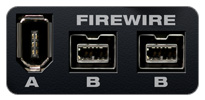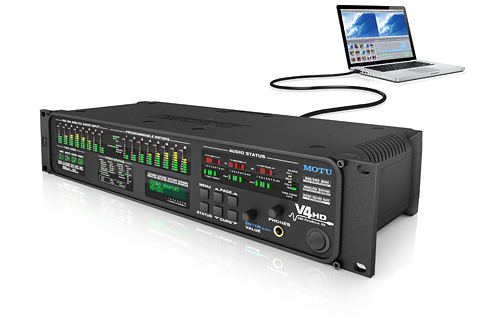Plug-and-play FireWire
The V4HD connects to the computer via FireWire (either 400 or 800), and the FireWire ports on the V4HD are used solely for the purpose of connecting it to the computer. FireWire offers many advantages over PCI and graphics card video I/O solutions.

General advantages of FireWire
FireWire is a cross-platform standard on both Mac and Windows platforms. If you or your facility employ both Final Cut on the Mac and Premiere on Windows, you can freely use the V4HD on both types of systems. You can even move one unit between a Mac and PC: just unplug it from one and plug it in to the other. You don't even need to restart the computers.

FireWire is a true plug-and-play protocol. If your workflow requires that you move your V4HD video capture and monitoring capabilities among two or more computers, you can effortlessly do so. The V4HD stands alone when it comes to the flexibility of FireWire because it supports both FireWire 400 and 800 on both Mac and Windows. No other video capture solution comes close to providing the depth and breadth of the FireWire support offered by the V4HD.

Laptop operation
Are you thinking about doing field capture with a laptop — or editing on the go with a laptop-based system? Thanks to FireWire, the V4HD opens the door to a world of possibilities for laptop systems.
All current and late-generation Apple MacBook and MacBook Pro computers are equipped with both FireWire 400 and 800. Most PC laptops are equipped with built-in 4-pin FireWire 400. In both cases, the V4HD gives you plug-and-play broadcast-quality capture and monitoring. With the enormous performance gains seen in laptop technology, these compact computers are now powerful enough to easily capture and play back both HD and uncompressed SD video. You can essentially build a complete capture/edit system that fits in a backpack.
There's another major benefit for using FireWire connectivity to a laptop. Using FireWire for video I/O frees up the PC card slot on your laptop for professional-grade video storage solutions. Expresscard-based storage solutions offer enough storage space and access speed to support the most demanding HD and uncompressed SD workflows.
Alternatively, depending on your workflow, you can daisy-chain a FireWire 800 hard drive on the same bus as the V4HD connected to the computer via FireWire 800. This option offers compact, portable yet large-scale storage.
Ingesting video from a camera that has built-in FireWire
Many cameras are equipped with built-in FireWire and connect directly to the computer, allowing you to ingest video directly from the camera. So why would you need the V4HD in this case? Below are several scenarios in which using the V4HD provides significant advantages.
Consolidating your workflow
When you capture output directly from a camera via FireWire, the resulting clips are brought into your NLE in the native format of the camera. For example, if you have an HDV camera, the clips come in as HDV clips. If you are bringing in material shot from two or three different cameras, each with their own capture format, the problem gets even worse because now your clips don't match. The V4HD helps you consolidate your workflow into a single format that you choose. For example, you might decide that you would prefer to work in ProRes in Final Cut. The V4HD speeds your capture process by ingesting any source directly to ProRes format. Just connect the source via SDI, component or any of the other offered on its rear panel, and your resulting clips are captured in ProRes format, without the extra step needed to transcode them.
Capturing uncompressed directly from the camera's image sensor
More and more cameras today provide SDI output straight from their image sensor, before the video signal is processed by the the compression chip in the camera and then streamed to tape, a hard drive or a storage card. If you are shooting in a situation where you can capture directly to your computer (perhaps a laptop), you can essentially capture the raw, uncompressed output from your camera straight into the computer via the V4HD's HD-SDI input and capture it as uncompressed SD or as compressed HD in either Apple ProRes format (in Final Cut) or DVCProHD format (in either Final Cut or Premiere). This is an especially useful capture workflow for HDV cameras because you bypass the HDV compression altogether and instead feed the raw uncompressed output from the camera directly into either ProRes or DVCProHD.
The V4HD provides up to 16 simultaneous channels of audio capture and playback with Final Cut Pro in any of four support audio formats: analog, AES/EBU, optical and embedded.











 Features
Features